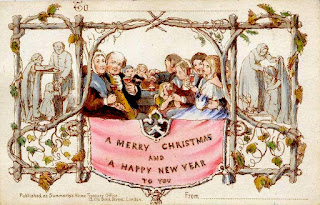The Roots of Christmas Traditions
 |
| In the 1950s we discovered fun and affordable Christmas plastic |
Our families have so many holiday traditions, in each family we have developed things that we hold dear as making Christmas OUR Christmas. I was curious as to how these happened so...
When you send that holiday card to your list, know that the first holiday greeting cards were commissioned in 1843
by a very clever Henry Cole who had John Callicot Horsley illustrate them.
Sheer marketing genius, as Cole was a government worker who had helped come up
with the idea of the post office and the “Penny Post” two years previously as a
way of giving ordinary people easy access to sending and receiving mail in
England. The age of steam made it all
work because trains were replacing the horse and carriage conveying mail and
packages quickly long distances. The price went down even further when you
could mail a card for a half penny if the envelope wasn’t sealed, just tucked
in. I remember sending cards cheaply a long time ago in the USA too, same thing, tuck in the flap and don't seal the card.
 |
| The very first holiday card, there was a lot of criticism for showing wine, how risque! |
Christmas and holiday cards exploded when the Royal Family elected to use a card
to send greetings to their general public at Christmas in the 1840s. Their card
with the family Christmas tree on it launched another over the top tradition: the modern Christmas
tree. Suddenly, a tree decorated with ornaments and little presents became all
the rage and it traveled quickly from England to America.
The history of the
original tree is a little cloudy but Evergreen boughs brought in and decorated
and later trees are thought to have come from Eastern Europe, as the tree is a
symbol of “Evergreen” long life. In
Germany during the renaissance guildhalls would erect trees covered with candies
for children to enjoy. The glass
ornament also came out of Germany and became enormously popular as it was both
affordable and beautiful.
 |
| My sister Marji, in the 1970s, the Queen of Christmas! |
 |
| Wouldn't you love to shop this display? |
Interestingly enough, originally the Christmas tree was
decorated on Christmas eve along with hanging stockings and came down soon
after. It was lit just one time, with candles, which were a horrible fire hazard, hence the one time lighting and candles were expensive too. When
the electric light string was invented we extended the tree season by weeks!
 |
| My inherited German ornaments from my family. My ultimate Christmas treasure |
 |
| 1954, stocking hanging with stockings made in Hong Kong |
In the 1950s in postwar American stockings became
specialized parts of our Christmas decor, and because regular stockings couldn’t
hold enough goodies, we imported great big ones and filled them with fruit and
and nuts and candy and presents. Every stocking has to have a candy cane too.
Candy canes are said to have come from Cologne Germany via a
thoughtful choir master who had a local candy maker make sugar sticks to keep
his young choir silent in the choir loft during Christmas eve services. They were white to show Jesus’ blameless life
and crooked to honor the shepherds. No one knows for sure when peppermint and
stripes were added but today they are a tradition found all across America.
 |
| Now that is a tree! |



Comments
Post a Comment